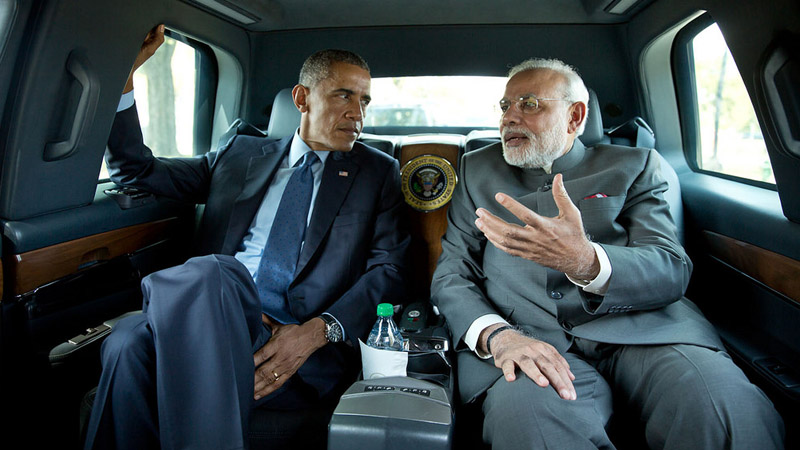Narendra Modi lands in the US this week for a 7 June meeting with US president Barack Obama, likely the final bilateral between the pair before Obama leaves office.
The ‘bromance’ between the pair has been remarkable, say observers. Security, defence, trade along with energy and climate change are set to dominate talks between the world’s second and fourth largest greenhouse gas emitters.
India wants to join the Nuclear Suppliers Club, which determines rules for how nuclear technologies are traded globally. Pakistan and China are opposed to India gaining membership.
On climate, there are myriad talking points says Andrew Light, until earlier this year a State Department and White House climate advisor, now with the World Resources Institute.
“Climate and energy is an area where both men have a meeting of minds, with some domestic political risk for both. They have both come forward and embraced an active agenda on climate and clean energy,” he says.
Below Light lists three areas to keep an eye on.
-Mission Innovation and the Global Solar Alliance: How can these work in tandem?
-Paris Agreement: Will India ratify by the end of this year? Does it need anything from the US to make that happen?
-HFCs: There are a lot of differences here, but a few stand out. One is the target year for freezing HFC use. India says 2030, the US says 2029. Second – how does the finance package look? Under other Montreal Protocol initiatives the incremental cost for countries to change technologies is supported. But India wants the full cost paid.
Ahead of the visit the US and India have signed a climate and energy MOU. It’s light on detail but covers smart cities, energy efficiency, grid access and development.
US in China
…before India comes Beijing, where US secretary of state John Kerry and climate envoy Jonathan Pershing meet their Chinese counterparts for the latest China-US Strategic and Economic Dialogues. This was the forum where climate links between the two countries developed in the past few years, culminating in the 2014 US-China climate pact.
As I said at opening of US-#China Strategic & Economic Dialogue: It's up to us to ensure that America & China are more partners than rivals.
— John Kerry (@JohnKerry) June 6, 2016
Tracking climate
Staying in India, the country’s meteorological organisation announced over the weekend that space agencies of more than 60 countries “agreed to engage their satellites, to coordinate their methods and their data to monitor human-induced greenhouse gas emissions”.
Tree selfies
Only in India – to mark Global Environment Day 2016 the government has encouraged eager tree-planters to take a picture with their handiwork (see ideal technique below). “Urban forestry is the new thrust area and we will be taking up massive tree plantation drive in as many as 200 cities and towns across the country” said climate chief Prakash Javadekar.
मैंने तो पर्यावरण के प्रति अपना कर्त्तव्य निभा दिया, क्या आपने अपना कर्त्तव्य निभाया??? @PrakashJavdekar @BJP4India pic.twitter.com/jGpjDSY1Wn
— Arjun Ram Meghwal (Modi Ka Parivar) (@arjunrammeghwal) June 5, 2016
EU energy talks
Ministers meet in Luxembourg this week for further discussions on the bloc’s long-term energy plans. Don’t expect much of note: a well-placed source tells Climate Home the European Commission is keen officials keep a low profile until the UK referendum on its future in the EU takes place on 23 June.
A message from our partners at the GEF:
From June 7-9, 2016, the GEF Council will meet for the 50th time. Following the adoption of the Sustainable Development Goals and the Paris Climate Agreement last year, the meeting comes at a critical moment for the future of the planet and its peoples.
It is also a special meeting because 2016 marks the 25th anniversary of the GEF being at the forefront of tacking the planet’s most pressing environmental problems. In its 25-year history, the GEF has invested some $14.5 billion – and leveraged an additional $75.4 billion – for nearly 4,000 projects in 167 countries.
EU: A secure climate?
Not that the referendum is keeping think tanks quiet. Far from it – this is the type of febrile atmosphere where they thrive. London-based think tank E3G has a report out warning climate stability is a “pillar of EU security”.
Later this month EU heads of state (with or without the UK) will agree on a new global security strategy, and E3G wants climate to be at its heart.
“Global trade in clean technology needs to become the core focus of EU energy diplomacy. This should shape the EU’s diplomatic engagement with large energy consumers and producing countries, in the Clean Energy Ministerial, the G7, G20, and EU-China and EU-US Energy Summits.
“At the same time, diplomatic efforts should focus on maximising the impact of European climate finance on delivering the INDCs, and redirect flows of public and private investment away from high risk, high carbon assets towards low risk, low carbon and resilient options.”
Also, E3G wants the EU to phase out “all fossil fuel subsidies from its budget” by 2021. Good luck with that one you may howl, given many countries don’t count the tax breaks or state support to oil, gas and coal companies as subsidies.
Divestment watch
Washington DC’s $6.4 billion city council pension fund says it has a BIG announcement out tomorrow on its plans to ditch oil, gas and coal holdings. The pension has come under sustained pressure for nearly three years to join the fast-growing divestment movement.
Join us next week for #YouthStats on Environment &Climate Change https://t.co/ZYKOytjGWq @UNEP @UNFCCC #GlobalGoals pic.twitter.com/xxRKsnMI5r
— UN Youth Office (@UNYouthAffairs) June 5, 2016
And finally…
Remember the global warming temperature spiral developed by Reading University climate scientist Ed Hawkins? It’s now available in 3D.
The temperature spiral that went viral is now available in 3-D via @ed_hawkins #climatechange #climateaction pic.twitter.com/qgvH5srHjQ
— World Meteorological Organization (@WMO) June 3, 2016
